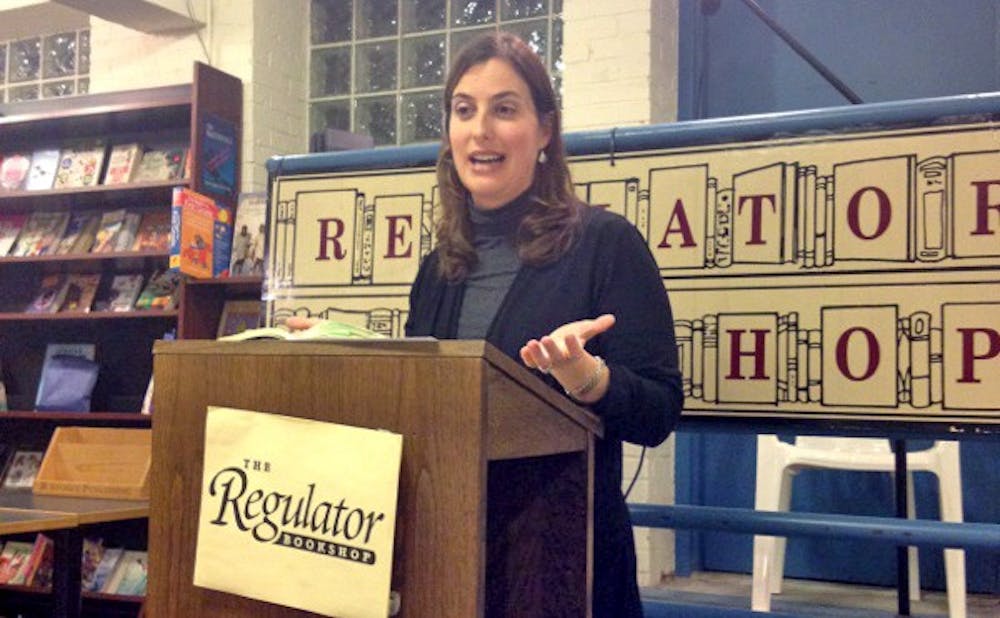An alumni of the Divinity School presented her memoir on marrying a former Hindu Monk on Tuesday.
J. Dana Trent, Divinity ‘06 ordained in the Southern Baptist Tradition, read from her memoir “Saffron Cross: The Unlikely Story of How a Christian Minister Married a Hindu Monk,” which details the struggles and joys of her relationship and marriage with Fred Eaker, a devout Hindu. From meeting on eHarmony.com to spending weeks in India together, Trent discussed how her relationship with Eaker shaped her understanding of God.
“It’s an East-meets-West, boy-meets-girl love story with a theological twist,” Trent said.
The event was held at The Regulator Bookshop on Ninth Street. There were 11 people in attendance, many of whom stayed after the event to purchase a copy of the book and discuss the author’s ideas with her.
Trent met Eaker in 2008 on the online dating site, eHarmony.com, where her profile listed her as willing to date someone from a non-Abrahamic tradition.
“The possibility that I’d get matched with anyone who wasn’t a Christian is minute, anyway, right? Right, God giggled,” Trent read.
She went on to describe the couple’s first date at the Blue Corn Café on Ninth Street. The Regulator Bookshop, the venue for the presentation, was special to Trent, since she and Eaker spent many subsequent dates there.
Deciding how the two would worship was a question the couple had to deal with. While Eaker insisted that they worship together, both wanted to ensure that they maintained each of their own traditions.
“We’re talking about solving a complex puzzle that has, according to most religious circles, diametrically opposing theological tenants,” Trent read. “There was no meeting in the middle with Moses, or Abraham, or the Trinity.”
Both Trent and Eaker, who was also present at the event, expressed their happiness that their families and faith communities were accepting of their union.
“We are very fortunate to belong to two faith communities that are extremely progressive,” Trent said. “My church has welcomed Fred—he teaches Sunday School, we had our book opening there. The Hindu community has welcomed me, and we’ve had the support of our faith communities and families, surprisingly.”
The couple also described the spiritual growth they have experienced as a result of learning about the other’s faith.
“Prayer in the two traditions are very different: extemporaneous vs. chanting,” Trent said. “I’ve adopted chanting and found that it’s very helpful for me.”
Eaker described how having a Christian wife has changed his relationship with God.
“The philosophy in Hinduism is that one’s nature is to serve God, and that asking God for things to maintain our mundane existence is not ideal,” Eaker said. “In my relationship with Dana and her extemporaneous prayer, I’ve become much more softened to asking God for help.”
The couple also detailed some of the challenges they faced in building their interfaith relationship and home. Trent, who was raised in an evangelical tradition, talked about her difficulties resisting the urge to proselytize her husband.
“I did sort of brainstorm ways early on in our courtship for how to get him baptized,” Trent exclaimed. “This is the first misstep in interfaith communication—us trying to convert one another instead of trying to understand one another.”
Audience questions for Trent and Eaker ranged from basic—“Do Hindus read the Bible?”—to personal—“How have your families reacted to your union?”—to theological—“What do you each see as the most valuable parts of the other’s faith tradition?”
Kimberly Caulfeild, another audience member, spoke highly of Trent and Eaker.
“I found it remarkable that she was willing to say things that could be embarrassing to some people, but she was open and honest about it,” Caulfeild said.
According to an Op-Ed in the New York Times,“Interfaith Unions: A Mixed Blessing” by Naiome Schaefer Riley, interfaith marriages are becoming more common, but result in divorce more often than those between members of the same religion. Before the 1960’s, only 20 percent of marriages were interfaith, but since 2000, approximately 45 percent of marriages in America were between members of different faiths, Schaefer reported from her research on religion.
“Our prayer has been from the beginning that Saffron Cross will be a manual not just for interfaith marriages or interfaith couples, but for interfaith friends,” Trent said. “Everyone’s theological perspective has meaning and validity because we are all human.”
Get The Chronicle straight to your inbox
Signup for our weekly newsletter. Cancel at any time.

